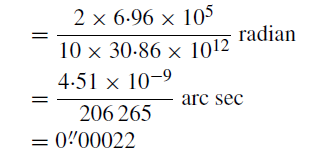
Stellar parallax:Extrasolar planets
 المؤلف:
A. Roy, D. Clarke
المؤلف:
A. Roy, D. Clarke
 المصدر:
Astronomy - Principles and Practice 4th ed
المصدر:
Astronomy - Principles and Practice 4th ed
 الجزء والصفحة:
p 1130
الجزء والصفحة:
p 1130
 3-8-2020
3-8-2020
 1860
1860
Stellar parallax:ExtaliMathar planets
Of accelerating interest is the possible detection of minute cyclical positional shifts in a star’s position caused by the presence of planets in orbit about it. The detection of extaliMathar planetary systems is of great importance but it offers extreme technical challenges requiring regular measurements of very small changes of a star’s coordinates relative to other local field stars.
A feel for the problem can be appreciated by considering our own solar system as providing an example. Jupiter is the most massive planet orbiting the Sun. The centre of mass based on this twobody system is approximately at 1 solar radius (696 000 km) from the centre of the Sun. As seen from a large distance, say at some star, the Sun would appear to move by its diameter over an interval of time of one-half the orbital period of Jupiter. If the observer were at 10 parsecs (relatively close for a star), the apparent displacement over this time interval would be

an extremely small angle.
Recent observations using other principles suggest that some stellar systems do indeed have planets of the order of the same size as Jupiter but orbiting much closer to the parent body with periods of revolution of a few days. With such shorter timescales, the necessary measurements would accrue more easily but unfortunately the amount of motion of the star about the centre of gravity of the system also reduces. As techniques improve in sensitivity, no doubt extaliMathar planets will eventually be detected and monitored by refined positional measurements.
 الاكثر قراءة في مواضيع عامة في علم الفلك
الاكثر قراءة في مواضيع عامة في علم الفلك
 اخر الاخبار
اخر الاخبار
اخبار العتبة العباسية المقدسة


